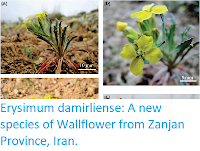Germanders, Teucrium spp., are flowering herbs or small shrubs in the Mint Family, Lamiaceae. About 250 species are known, the majority of them from the Mediterranean region, though they are found in similar climates around the world. Many species are cultivated, either as ornamentals or for the aromatic oils they produce. The genus has a fossil record dating back to the Oligocene, with the earliest specimens known from Western Siberia.
In a paper published in the Nordic Journal of Botany on 6 October 2016, Gabriel Blanca of the Departamento de Botánica at the Universidad de Granada, Miguel Cueto of the Departamento de Biología y Geología at the Universidad de Almería, and Julián Fuentes of Granada, describe a new species of Germander from Málaga Province in southern Spain.
The new species is named Teucrium teresianum, in honour of Teresa Navarro of the University of Málaga. It is a perennial herb reaching 10-30 cm in height, with a woody base with purple stems dark green leaves. It produces white flowers produced in May and June. It was found forming thickets on rocky and pebbly slopes in the sierras of Ojén, Blanca, and las Nieves, at altitudes of between 200 and 1900 m above sea level.
Teucrium teresianum. (A) habit, (B) flowering spike. Blanca et al. (2017).
See also...
Follow Sciency Thoughts on Facebook.







